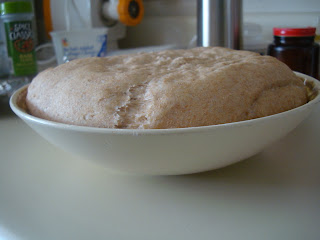Recipe: half whole wheat bread (1 medium loaf)
Ingredients:
- 1.5 cup KAF whole wheat flour
- 1.5 cup KAF unbleached bread flour
- 1.5 tp salt
- 2 generous tps active dry yeast
- 2 TB olive oil
- 3 TB honey
- 1+1/3 cup very warm water
Procedure:
1. Mix together flour and salt. Proof yeast in 3 TB warm water. Then add to flour mixture. Add water 1/4 cup at a time and start mixing.
2. When a smooth dough has formed, allow dough to proof for a few hours in warmth, covered with plastic. After each time of volumed-doubling, punch dough down.
3. Rub in honey and oil after the first proof.
4. Shape dough into a log.
5. Grease a 4x8 loaf pan with crisco vegetable shortening.
6. Proof dough log in loaf pan until volume doubles. Then bake at 350F for about 40 minutes.
7. Turn loaf out and let cool. Then slice.
Results:
9:39am, initial mixture:
10:03am, dough formed and ready to rest:
10:18am, dough resting in the warmth of an oven heated at 150F for 5 seconds:
1:12pm, dough rested 3 hours:
1:12pm, dough's height after rest; observe the crack on the dried surface due to rapid expansion:
1:13pm, dough's texture:
1:13pm, dough punched down and reshaped:
1:14pm, dough to proof again:
2:13pm, dough proofed 1 hour, observe the dry surface:
2:52pm, dough's height:
2:53pm, dough's texture:
2:58pm, dough with honey and olive oil:
3:05pm, dough to proof the third time:
3:05pm, dough's height at the start of the third proof:
3:32pm, dough proofed 30 minutes:
3:32pm, dough's height after proofing:
3:39pm, texture of dough, with small pockets of dried dough skin in it:
3:42pm, dough to proof the fourth time:
3:42pm, dough's height at the start of the fourth proof:
4:01pm, dough proofed 19 minutes:
4:02pm, dough proofed height:
4:05pm, brushing water on top of dough:
4:06pm, to bake at 350F:
4:31pm, loaf baked 25 minutes:
4:31pm, loaf's height:
4:31pm, loaf rubbed with butter:
4:34pm, loaf at 160F:
4:34pm, loaf to resume baking, covered loosely:
4:47pm, loaf baked 35 minutes:
4:48pm, thermometer coming out clean:
5:10pm, loaf's baked top:
5:10pm, loaf's height:
5:16pm, loaf turned out:
5:16pm, loaf's side:
5:16pm, loaf's heel:
5:16pm, loaf's bottom:
7:59pm, loaf's interior:
7:59pm, loaf's center, with mark of thermometer poking through:
7:59pm, loaf's center slice without thermometer mark:
8:01pm, crust:
8:01pm, crumb, with a soft spongy texture, still warm:
Observations:
1. Because of the good warm temperature and the good hydration of the dough, the dough rises really nicely in this experiment.
2. However, I have not been careful to cover the dough each time it rises. This results in the surface of dough drying out. When the dried surface gets broken into small pieces and redistributed into the dough, it creates small pockets of dried dough.
3. I leave the loaf in the oven a little longer than I should. Normally, the loaf should be taken out of the oven once it is done. I leave it in the oven for 15 minutes even without turning on the oven. As a result, the crust of this loaf is exceptionally hard.
4. Two things would have made this loaf a perfect loaf: (1) to cover the dough carefully during the proofing so that small pockets of dried skin won't form; (2) to remove the loaf from oven once it is done.












































No comments:
Post a Comment